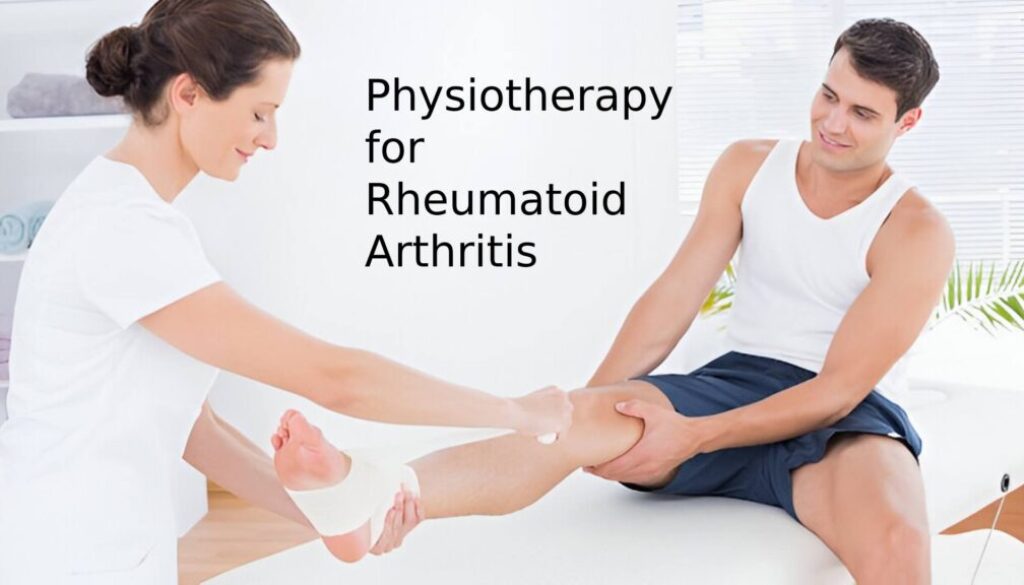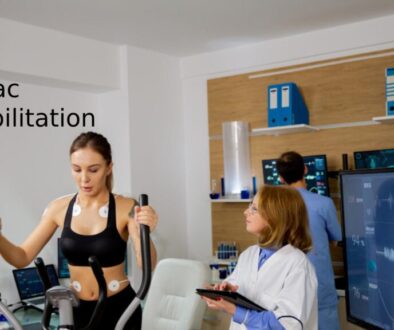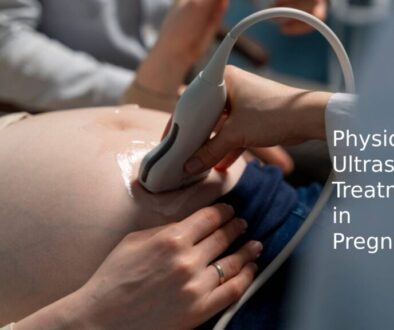Physiotherapy for Rheumatoid Arthritis: A Treatment Guide
Introduction
Rheumatoid arthritis (RA) is a chronic autoimmune condition that causes inflammation, pain, and joint stiffness. Unlike osteoarthritis, which results from wear and tear, RA occurs when the immune system mistakenly attacks the joints, leading to damage over time. Managing RA effectively requires a combination of medication, lifestyle modifications, and physiotherapy.
Physiotherapy plays a crucial role in RA management by helping patients maintain mobility, reduce pain, and prevent joint deformities. With the right physiotherapy approach, individuals with RA can improve their quality of life and continue performing daily activities with less discomfort.
In this article, we will explore how physiotherapy can benefit RA patients, the best techniques used, and how to incorporate these methods into daily life.
Understanding Rheumatoid Arthritis
What is Rheumatoid Arthritis?
Rheumatoid arthritis is an autoimmune disorder where the immune system attacks the synovial lining of the joints, leading to chronic inflammation. Over time, this inflammation can cause joint damage, deformities, and loss of function.
Causes and Risk Factors
The exact cause of RA is unknown, but several factors increase the risk, including:
- Genetic predisposition
- Hormonal changes
- Environmental triggers (e.g., smoking, infections)
- Obesity
- Chronic stress
Common Symptoms and Progression
RA typically starts in smaller joints, such as the fingers and toes, and progresses to larger joints. Common symptoms include:
- Joint pain and stiffness, especially in the morning
- Swelling and redness around affected joints
- Fatigue and general weakness
- Fever and weight loss in severe cases
Without proper treatment, RA can lead to joint deformities and reduced mobility, making early intervention crucial.
The Role of Physiotherapy in Rheumatoid Arthritis (RA) Management
Physiotherapy is essential for RA patients as it helps:
- Reduce pain and inflammation through targeted exercises and techniques
- Improve joint flexibility and mobility to prevent stiffness
- Strengthen muscles around affected joints to provide better support
- Enhance posture and body mechanics to reduce strain on joints
- Promote overall physical activity to prevent muscle atrophy
A physiotherapist customizes treatment based on disease severity, joint involvement, and individual capabilities, ensuring a safe and effective approach.
Key Physiotherapy Techniques for RA
Physiotherapy for RA includes several techniques, each targeting different aspects of joint health and pain relief:
- Exercise Therapy – Tailored physical activities to improve mobility and strength.
- Manual Therapy – Hands-on techniques to enhance joint movement.
- Hydrotherapy – Water-based exercises that reduce strain on joints.
- Electrotherapy – Use of electrical stimulation to manage pain and inflammation.
A combination of these methods often yields the best results for RA patients.
Exercise Therapy for RA Patients
Benefits of Regular Movement
Many RA patients fear movement due to pain, but controlled physical activity can:
- Reduce joint stiffness
- Strengthen muscles
- Improve circulation and reduce swelling
Types of Recommended Exercises
- Low-impact aerobic exercises (e.g., walking, cycling, swimming)
- Stretching and flexibility exercises (e.g., yoga, tai chi)
- Strength training (e.g., resistance bands, light weights)
Strengthening vs. Flexibility Exercises
Strengthening exercises focus on improving muscle support around joints, while flexibility exercises prevent stiffness and maintain range of motion. A combination of both is ideal for RA patients.
Manual Therapy and Joint Mobilization
What is Manual Therapy?
Manual therapy is a hands-on approach used by physiotherapists to manipulate and mobilize joints and soft tissues. It involves techniques such as joint mobilization, massage, and stretching to improve mobility and reduce stiffness.
Benefits of Joint Mobilization in RA
RA can cause joints to become stiff and painful, leading to restricted movement. Manual therapy helps by:
- Improving joint flexibility – Gentle movements help loosen stiff joints.
- Enhancing circulation – Increased blood flow to affected areas reduces inflammation.
- Reducing pain – Soft tissue manipulation alleviates discomfort.
- Preventing joint deformities – Regular mobilization helps maintain joint alignment.
Techniques Used by Physiotherapists
- Gentle Oscillations – Small, repeated movements to relieve stiffness.
- Soft Tissue Massage – Eases muscle tension and promotes relaxation.
- Joint Mobilization Exercises – Helps restore normal movement patterns.
Manual therapy should always be performed by a trained professional to avoid further joint damage.
Hydrotherapy: Water-Based Exercises for RA
How Hydrotherapy Benefits Rheumatoid Arthritis(RA) Patients
Hydrotherapy, or aquatic therapy, involves performing exercises in warm water. The buoyancy of water reduces stress on joints, making movement easier and less painful. Warm water also soothes sore muscles and improves circulation.
Recommended Water Exercises
- Walking or jogging in water – Reduces joint impact while strengthening muscles.
- Leg lifts and arm circles – Enhances flexibility and mobility.
- Floating stretches – Eases stiffness and improves range of motion.
- Resistance training with water weights – Builds strength with minimal joint strain.
Safety Tips for Hydrotherapy
- Ensure the water temperature is warm (around 33-36°C).
- Use flotation devices if needed for support.
- Avoid overexertion – listen to your body’s limits.
- Consult a physiotherapist before starting hydrotherapy.
Hydrotherapy is an excellent option for RA patients who struggle with land-based exercises due to pain and stiffness.
Electrotherapy and Pain Management
How Electrotherapy Helps with RA Pain
Electrotherapy uses electrical impulses to stimulate nerves and muscles, helping to relieve pain and inflammation. It is a non-invasive, drug-free method of managing RA symptoms.
Types of Electrotherapy Used in Physiotherapy
- Transcutaneous Electrical Nerve Stimulation (TENS) – Sends electrical signals to nerve endings to reduce pain perception.
- Ultrasound Therapy – Uses sound waves to generate heat, reducing stiffness and increasing circulation.
- Interferential Therapy (IFT) – Delivers low-frequency electrical currents to reduce deep tissue pain.
- Laser Therapy – Helps reduce inflammation and promote healing.
Risks and Considerations
- Should be used under professional supervision.
- Not suitable for individuals with pacemakers.
- May cause skin irritation in some cases.
Electrotherapy can be a valuable addition to RA management, particularly for those experiencing persistent pain.
Assistive Devices and Physiotherapy Aids
Importance of Assistive Devices for RA Patients
As RA progresses, certain joints may become too weak or painful to function properly. Assistive devices help reduce joint strain and improve mobility.
Commonly Used Tools
- Braces and Splints – Provide support and prevent joint misalignment.
- Walking Aids (Canes, Walkers, Crutches) – Reduce pressure on affected joints.
- Adaptive Utensils – Specially designed tools to ease daily tasks like eating and dressing.
- Compression Gloves – Improve circulation and reduce hand stiffness.
How Physiotherapists Recommend Assistive Devices
A physiotherapist assesses an individual’s needs and recommends appropriate aids based on:
- The severity of joint damage
- The patient’s level of activity
- Specific daily challenges the patient faces
Using assistive devices correctly can enhance independence and quality of life.
Lifestyle Modifications for Better RA Management
Ergonomic Adjustments
Making small changes to your work and home environment can help prevent unnecessary joint strain. Some ergonomic tips include:
- Using chairs with good lumbar support.
- Adjusting desk height for better posture.
- Using voice-to-text software to reduce hand strain.
Importance of Posture and Movement Modifications
Maintaining good posture minimizes joint stress. Physiotherapists teach RA patients how to:
- Distribute weight evenly while standing.
- Avoid repetitive movements that strain joints.
- Use proper lifting techniques.
Stress Management and Relaxation Techniques
Since stress can exacerbate RA symptoms, physiotherapists often recommend:
- Deep breathing exercises – Helps relax muscles and reduce tension.
- Meditation and mindfulness – Lowers stress levels and improves pain tolerance.
- Yoga and stretching – Enhances flexibility and reduces stiffness.
A well-rounded approach that includes physiotherapy, lifestyle modifications, and stress management can significantly improve RA symptoms.
Physiotherapy for Hands and Fingers in RA
How RA Affects Hand Function
RA commonly affects the small joints of the hands, leading to:
- Stiffness and pain in the fingers.
- Swelling and reduced grip strength.
- Difficulty performing everyday tasks like writing and buttoning clothes.
Special Hand Exercises for RA
- Finger Stretching – Helps maintain flexibility.
- Grip Strengthening – Improves hand function.
- Thumb and Wrist Movements – Prevents joint stiffness.
Using Compression Gloves and Splints
- Compression gloves enhance circulation and reduce swelling.
- Splints provide support and prevent further deformities.
- Physiotherapists can guide patients on proper usage.
Physiotherapy for Lower Limbs and Walking Ability
Impact of RA on Knees and Ankles
RA often affects weight-bearing joints, leading to pain and instability in the lower limbs. Walking may become difficult due to:
- Joint swelling in the knees and ankles.
- Weak muscles supporting these joints.
- Loss of balance and coordination.
Strengthening Leg Muscles
- Leg Raises – Strengthens the quadriceps.
- Calf Stretches – Reduces stiffness in the ankles.
- Resistance Band Exercises – Builds lower limb strength.
Improving Walking Mechanics
Physiotherapists teach RA patients how to walk correctly by:
- Encouraging a heel-to-toe walking pattern.
- Ensuring even weight distribution.
- Using orthotic insoles if needed.
Regular physiotherapy helps maintain mobility and prevents falls.
Managing Fatigue and Stiffness Through Physiotherapy
Understanding Fatigue in RA
RA-related fatigue is caused by inflammation, pain, and lack of sleep. It can significantly impact daily activities.
Stretching and Relaxation Techniques
- Morning Stretch Routine – Helps ease stiffness after sleep.
- Gentle Yoga – Improves flexibility without causing strain.
- Foam Rolling – Reduces muscle tightness.
Creating a Balanced Activity-Rest Schedule
- Alternate between activity and rest periods.
- Avoid overexertion to prevent flare-ups.
- Listen to your body’s signals and pace yourself accordingly.
Combining Physiotherapy with Other RA Treatments
Medications and Physiotherapy
Physiotherapy works best when combined with:
- Anti-inflammatory drugs
- Disease-modifying antirheumatic drugs (DMARDs)
- Biologic therapies
Diet and Exercise Synergy
- A balanced diet supports joint health.
- Foods rich in omega-3 fatty acids help reduce inflammation.
- Hydration is key to preventing muscle cramps.
Importance of a Multidisciplinary Approach
RA management involves:
- Physiotherapists – For mobility improvement.
- Rheumatologists – For medication adjustments.
- Dietitians – For nutritional guidance.
Conclusion
Physiotherapy is a powerful tool for managing rheumatoid arthritis. From exercise therapy to lifestyle adjustments, it helps reduce pain, maintain mobility, and improve overall well-being. With a personalized physiotherapy plan, RA patients can continue leading active and fulfilling lives.
FAQs
- How often should RA patients do physiotherapy?
At least 2-3 times per week, depending on symptoms. - Can physiotherapy reverse joint damage in RA?
No, but it can slow progression and prevent further damage. - Is yoga safe for RA patients?
Yes, but only gentle yoga with modifications. - Can physiotherapy replace RA medications?
No, but it complements medical treatment effectively. - What is the best exercise for RA patients?
Low-impact activities like swimming, cycling, and stretching.



